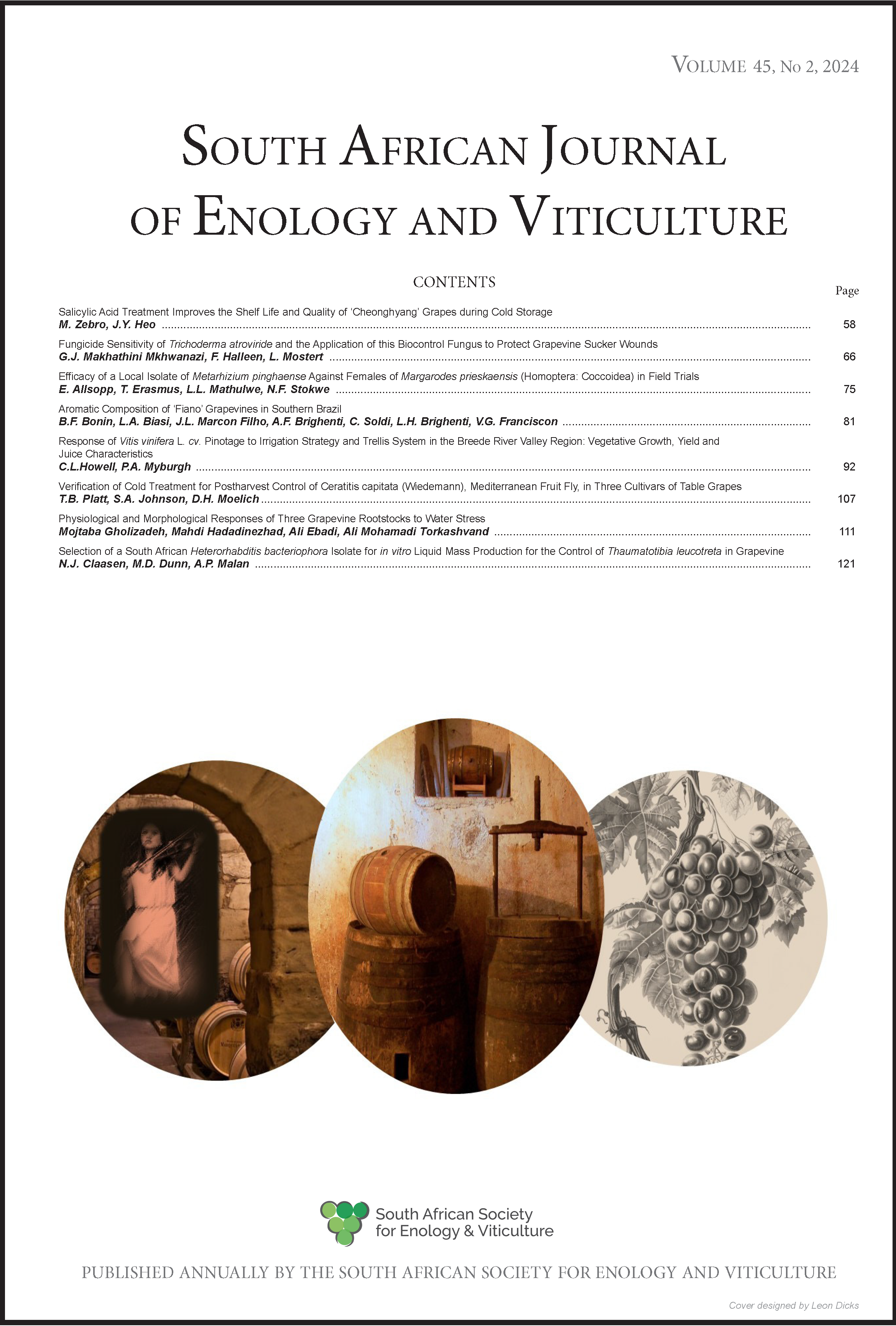Fungicide Sensitivity of Trichoderma atroviride and the Application of this Biocontrol Fungus to Protect Grapevine Sucker Wounds
DOI:
https://doi.org/10.21548/45-2-6464Abstract
It is known that Trichoderma spp. can protect winter pruning wounds effectively against infection by trunk disease pathogens. Another port of entry for trunk disease pathogens is spring sucker wounds. Trichoderma spp. hold the potential to be applied to grapevine sucker wounds to prevent infection by trunk disease pathogens. During spring, fungicides are regularly applied to control grapevine foliar and fruit diseases. The effect of these fungicides on T. atroviride is unknown. The efficacy of a T. atroviride-based commercial product, Eco-77®, was tested on sucker wounds in a vineyard against the trunk pathogens Phaeomoniella chlamydospora and Diaporthe ampelina. Sucker wounds were made on one-year-old wood of Cabernet Sauvignon vines. The wounds were spray-treated with Eco-77® immediately after suckering, and 24 hours later the sucker wounds were inoculated with spore suspensions of either P. chlamydospora or D. ampelina. After five months, isolations were made from the sucker wounds. Trichoderma atroviride reduced the incidence of P. chlamydospora by 66.65%. Even though the incidence of D. ampelina was reduced by 15.37%, it was not significantly different from the control treatment. In vitro sensitivity
studies were utilised to investigate the effect of fungicides applied during spring against other diseases (downy and powdery mildew, Botrytis rot and Phomopsis cane and leaf spot) on Trichoderma spp. The inhibition of mycelial growth and conidial germination of T. atroviride (UST1 and Eco-77®) were screened for 16 fungicides. Potato dextrose agar and broth was amended to obtain 0, 0.25, 0.5, 1 and 2 times the recommended dosages of the respective fungicides. Trichoderma spp. isolates were the least sensitive to the systemic fungicides boscalid, metrafenone and trifloxystrobin, as well as to the contact fungicides quinoxyfen and meptyldinocap for mycelial inhibition. These fungicides gave less than 50% mycelial inhibition at all the tested dosages. For the conidial germination assay, boscalid, penconazole and trifloxystrobin (systemic fungicides) gave less than 50% conidial germination inhibition of Trichoderma spp. Spiroxamine and pyrimethanil gave the highest mean percentage inhibition for both mycelial inhibition and conidial germination. The findings of this study show that T. atroviride can potentially be used to protect sucker wounds against P. chlamydospora. Furthermore, fungicides applied to grapevines during springtime can influence the conidial germination and mycelial growth of T. atroviride (UST1 and Eco-77®) to varying degrees. When applying Trichoderma spp. in spring, care needs to be taken in the timing of application of fungicides so as not to inhibit the growth of the biocontrol fungus.
Downloads
Downloads
Published
Issue
Section
License
A copyright form will be e-mailed to the corresponding author when the manuscript has been accepted for publication.
In principle, the Author agrees to the following when he/she signes the copyright agreement:
I hereby assign to the SOUTH AFRICAN SOCIETY FOR ENOLOGY AND VITICULTURE (SASEV) the copyright of the text, tables, figures, supplementary material, illustrations and other information (the Material) submitted with the manuscript to be published in SOUTH AFRICAN JOURNAL OF ENOLOGY AND VITICULTURE (SAJEV) (the "Article"). The copyright becomes effective from the date the Article has been accepted for publication in SAJEV.
This is an open access journal, and the authors and journal should be properly acknowledged, when works are cited.
Author's may use the publishers version for teaching purposes, in books, theses, dissertations, conferences and conference papers.
A copy of the authors' publishers version may also be hosted on the following websites:
- Non-commercial personal webpage or blog.
- Institutional webpage.
- Authors Institutional Repository.
The following notice should accompany such a posting on the website: This is an electronic version of an article published in SAJEV, Volume XXX, number XXX, pages XXX - XXX, DOI. Authors should also supply a hyperlink to the original paper or indicate where the original paper (www.journals.ac.za/index.php/sajev/) may be found.
Authors publishers version, affiliated with the Stellenbosch University will be automatically deposited in the University's Institutional Repository SUNScholar.
Articles as a whole, may not be re-published with another journal.
The following license applies:
Attribution CC BY-NC-ND 4.0

